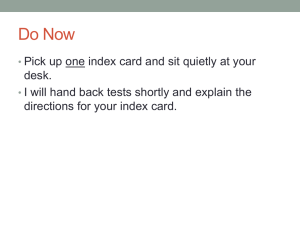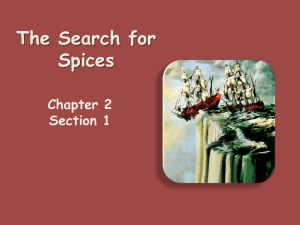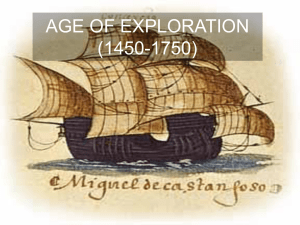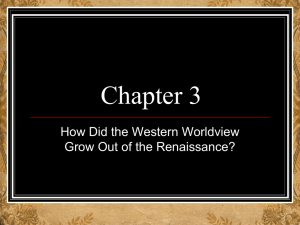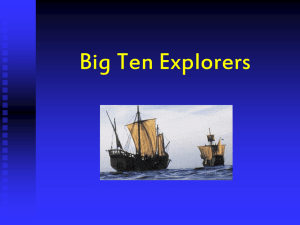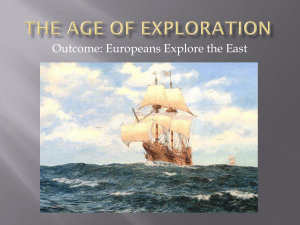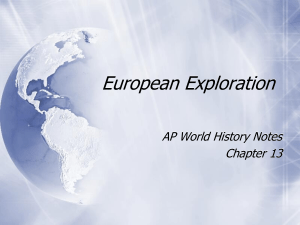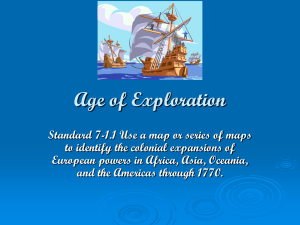Exploration
advertisement
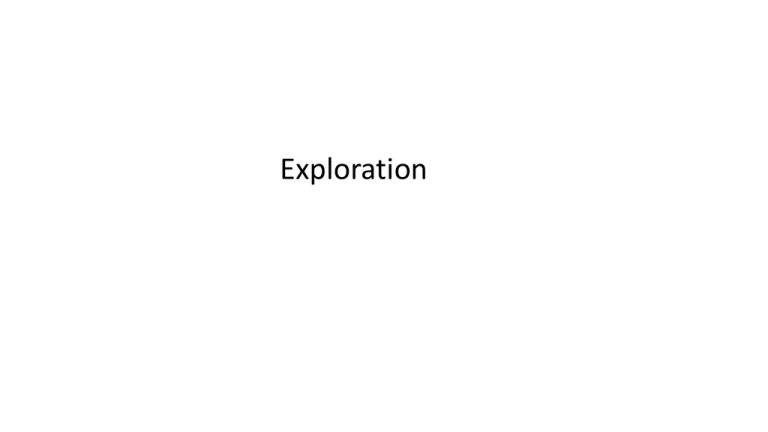
Exploration Beginning in the 1400s the Age of Exploration was when European countries expanded outside of its borders. Before the time Europe remained isolated from the rest of the world except for Marco Polo’s explorations in China in 1275. Europeans were motivated by the 3Gs God- Spread Christianity Glory- Find new territories for the monarchs Gold- Obtain wealth Europeans had been introduced to spices such as nutmeg, cinnamon, pepper, and ginger during the Crusades. Demand was higher than supply. Merchants were able to make great profits from the sale of spices. Following the Crusades Europeans believed it was their duty to continue to spread Christianity by converting non-Christians and fight the Muslims. Technology allowed for easier exploration for the Europeans The caravel was a new sturdier vessel. Triangular sails allowed for sailing against the wind. The astrolabe was used to calculate latitude. Also the magnetic compass was used for direction Portugal was the leader in using the innovations. They were also the first to establish trading outposts in West Africa. Governmental support helped with resources. Prince Henry the Navigator used his own fortune to fund 14 voyages and died in debt. Spain and Portugal became rivals in exploration. Pope Alexander created a dividing line. Spain would claim all land to the west-Portugal to the east The Treaty of Tordesilla moved the line farther west causing Portugal to fall off course landing in Brazil Portuguese Explorers Gaspar Corte Real: 1450-1501: Explored Greenland Bartolomeu Dias: 1457-1500: The first European explorer to lead a voyage around the Cape of Good Hope on the Southern most tip of South Africa. Pedro Alvares Cabral: 1467-1520: The first European explorer to reach Brazil Vasco da Gama: 1469-1524: Discovered and ocean route from Portugal to the East Ferdinand Magellan: 1480-1521: First to circumnavigate the world Spanish Explorers Christopher Columbus: 1451-1506: On his way to find India, discovered the New World, the West Indies. Francisco Pizarro: 1478-1541: Conquered the Incas in Peru Vasco Nunez de Balboa: 1475-1519: First European to see the Pacific Ocean from its eastern shore Juan Ponce de Leon: 1460-1521: First to reach Florida Francisco Vasquez de Coronado: 1510-1554: First to explore southwestern North America Hernando Cortes: 1485-1547: Conquered the Aztecs in Mexico Cabeza de Vaca: 1490-1557: First to explore Texas and the Southwest Panfilo de Narvaez: 1470-1528: explored Cuba Alfonso Pineda: 1494-1519: proved Florida was not an island Juan de Onate: 1550-1630: established the colony of New Mexico for Spain Juan Cabrillo: 1499-1543: First to explore to navigate the coast of California English Explorers Sir Francis Drake: 1540-1597: Circumnavigated the world Sir Walter Raleigh: 1552-1618: Discovered Guiana and established the Virginia colony of Roanoke Island Sir Humphrey Gilbert: 1539-1583: established St. Johns and Newfoundland Sir Richard Grenville: 1542-1590: Explored Virginia, Roanoke Island and the Azores Sir John Hawkins: 1532-1595: Explored South America and West Africa John Cabot: 1450-1499: Second to found North America, colonized Canada Sebatian Cabot: 1474-1557: Searched for Northwest Passage across North America and made expeditions to Russia Henry Hudson: 1565-1611: Discovered the what came to called the Hudson River French Explorers Jacques Cartier: 1491-1557: Led three expeditions to Canada Jacques Marquette: 1637-1675: Along with Louis Joliet, discovered the Mississippi River. Samuel de Champlain: 1567-1635: Known as the Father of Canada was the founder of Quebec City Italian Explorers Marco Polo: 1254-1324: China and parts of Asia Christopher Columbus was Italian but sailed for Spain Amerigo Vespucci was Italian but sailed for Spain Giovanna da Verrazzano: 1485-1528: was Italian but sailed for Franceexplored the Northeast coast of North America from Cape Fear to Maine Fray Marcos de Niza: 1496-1558: Discovering the Pueblo tribe called the Zuni Indians. Made to believe the myth of the "Seven Golden Cities of Cibola" Leif Eriksson The second son of Erik the Red, Leif Eriksson was on his way back home to Greenland, where Norway's King Olaf I had sent him to Christianize the natives, when he sailed off course and landed at what is now Nova Scotia, which he called Vinland. This account comes from the Icelandic Eiríks saga. Another account, the Groenlendinga saga, says he learned of Vinland from an Icelandic trader who had been there 14 years earlier. He never colonized the land he discovered, and he would never return to it once he headed back to Greenland after the winter was over. Explorer Amerigo Vespucci was born March 9, 1451, in Florence, Italy. On May 10, 1497, he embarked on his first voyage. On his third and most successful voyage, he discovered present-day Rio de Janeiro and Rio de la Plata. Believing he had discovered a new continent, he called South America the New World. In 1507, America was named after him. He died of malaria in Seville, Spain, on February 22, 1512. Zheng He Commanded a fleet of more than 300 ships, 50 treasure ships The fleet included more than 20,000 sailors and hundreds of ships. The ships were as long as 400 feet. (Columbus's ships, were less than 100 feet long.) Zheng He and his fleet went to on Seven Voyages to places like India, Ceylon, Arabia, Africa, and many other places, spreading the word about the glory of China. He brought back with him many tributes and many strange animals and plants.


